Solar Physics Historical Timeline (1600 - 1799)
Timeline
In this page
1609: The Sun in focus
An early convert to the Copernican system was Johannes Kepler (1571-1630). After ten years of laborious work using the accurate observations of planetary positions accumulated over 20 years by the astronomer Tycho Brahe (1546-1601), Kepler came to realize that the orbital paths of planets have the form of ellipses with the Sun at one focus, and that the radius vector joining a given planet to the Sun sweeps equal areas in equal time (today known as Kepler's first and second laws). In 1609 Kepler published his landmark Astronomia Nova, and in 1619 his Harmonice mundi, where what is now known as Kepler's third law is first laid out (the orbital period squared is proportional to the mean distance cubed). Using his planetary model and Brahe's observations, Kepler produced the Rudolphine Tables of planetary positions in 1627. These proved more accurate, by over an order of magnitude, than previous tables produced using the original planetary model of Copernicus.
References and further reading
- Thoren, V.E. 1989, Tycho Brahe, in The General History of Astronomy, vol. 2A, eds. R. Taton and C. Wilson, Cambridge University Press, pps. 3-21.
- Gingerich, O. 1989, Johannes Kepler, in The General History of Astronomy, vol. 2A, eds. R. Taton and C. Wilson, Cambridge University Press, pps. 54-78.
- Gingerich, O., and Voelkel, J.R. 1998, Journal for the History of Astronomy, 29, 1-34. Physics.
1610: First telescopic observations of sunspots
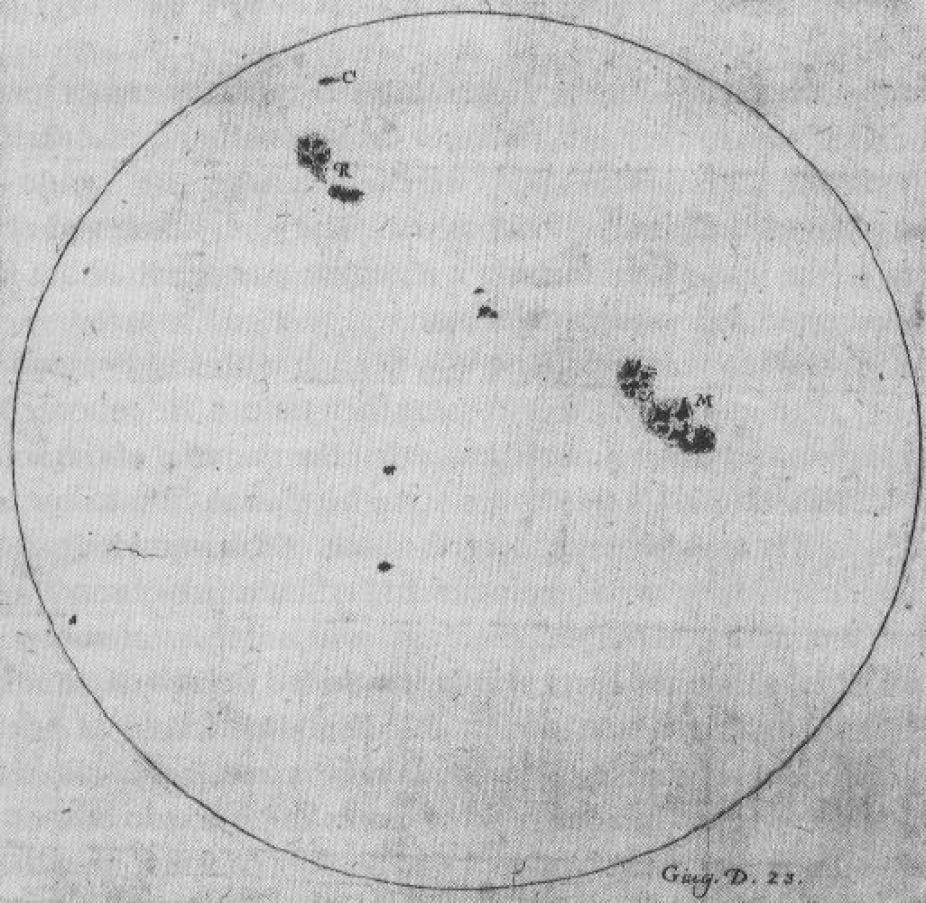
Reproduction of one of Galileo's sunspot drawings. The umbrae/penumbrae structure is clearly depicted on this June 23. 1612 drawing.
In the first decade of the seventeenth century, four astronomers nearly simultaneously turned the newly invented telescope toward the Sun, and noted the existence of sunspots. They were Johann Goldsmid (1587-1616, a.k.a. Fabricius) in Holland, Thomas Harriot (1560-1621) in England, Galileo Galilei (1564-1642) in Italy, and the Jesuit Christoph Scheiner (1575-1650) in Germany.
To Harriot belongs the oldest recorded sunspot observation, on December 8 1610, as evidenced by entries in his notebooks. However, he did not pursue these observations in any systematic or continuous manner at the time. Fabricius was the first to publish his results in 1611, and correctly interpreted the apparent motion of sunspots in terms of axial rotation of the Sun. Galileo and Scheiner, however, were the most active in using sunspots to attempt to infer physical properties of the Sun. To Galileo belongs the credit of making a convincing case that sunspots are indeed features of the solar surface, as opposed to intra-Mercurial planets (Scheiner's original position). Galileo's views were first laid out in detail in his 1613 Letters on Sunspots, written in response to Scheiner's own views on the matter (first published in 1612 under the pseudonym of Apelles in the form of three letters to Mark Welser (1558-1614), Augsburg Magistrate, patron of science, and scientific correspondent of both Scheiner and Galileo). Some years later Scheiner, in his massive 1630 treatise on sunspots entitled Rosa Ursina, accepted the view of sunspots as markings on the solar surface and used his accurate observations to infer the fact that the Sun's rotation axis is inclined with respect to the ecliptic plane (i.e., the plane of the Earth's orbit around the Sun).
The existence of ephemeral blemishes on the Sun's surface was in stark conflict with the then prevailing Ptolemaic/Aristotelian-based cosmology endorsed by the Roman catholic Church (after suitable modification to avoid open contradiction with the Scriptures). Galileo's views on sunspots contributed significantly the sequence of events that landed him in front of the Roman Inquisition in 1633. Officially, Galileo was condemned for disobedience to the Church, in the context of his open endorsement of the Copernican heliocentric planetary model. Growing animosity on the part of the Jesuits who, particularly through their chief astronomer Christopher Clavius (1538-1612), had been originally quite supportive of Galileo's early telescopic discoveries, also contributed to Galileo's downfall.
References and further reading
- Galileo, G. 1610, Sidereus Nuncius, trans. A. van Helden 1989, The University of Chicago Press.
- Galileo, G. 1613, Letters on Sunspots [in S. Drake (trans.) 1957, Ideas and Opinions of Galileo, Doubleday].
- Galileo, G. 1632, Dialogues concerning the two chief world systems, trans. S. Drake, 2nd edition 1967, University of California Press.
- Mitchell, W.M. 1916, The history of the discovery of the solar spots, in Popular Astronomy, 24, 22-ff.
- Shea, W.R. 1970, Galileo, Scheiner, and the interpretation of Sunspots, Isis, 61, 498-519.
- Drake, S. 1978, Galileo at work: his scientific biography, Chicago: The University of Chicago Press [1995 Dover reprint]
1644: The Sun as a star
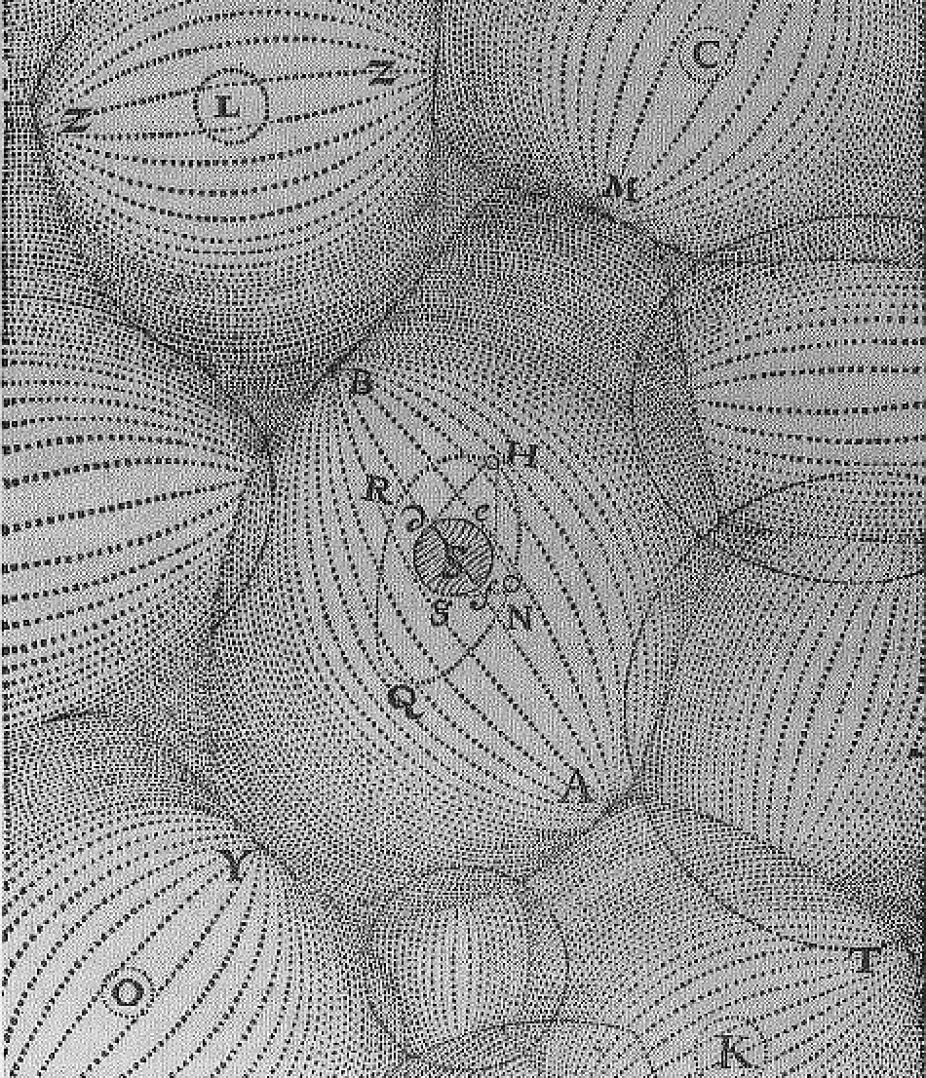
Detail of a diagram from the 1644 Principia philosophiae of René Descartes, depicting his conception of the cosmos as an aggregate of contiguous vortices, most with a star at their center. S is the Sun.
The Copernican system replaced the Earth with the Sun as the center of the universe, but otherwise maintained a clear distinction between the Sun and the "fixed" stars, distributed on the fixed, outermost sphere of the copernican cosmos. This last concession to humanity's cosmic centrality was rejected by the generation of Copernicans following Kepler and Galileo. Prominent among them was René Descartes (1596–1650) who, in his 1644 book Principia philosophiae, put forth a model of the cosmos in which the Sun is but one of many stars, each formed at the center of a primeval vortex. Descartes viewed sunspots as floating aggregates of ethereal matter, accreted along the Sun's rotational axis, where centrifugal forces are negligible.
References and further reading
- Aiton, E. J. 1989, The Cartesian Vortex Theory, in The General History of Astronomy, vol. 2A, eds. R. Taton and C. Wilson, Cambridge University Press, pps. 207-221.
1645-1715: Sunspots vanish
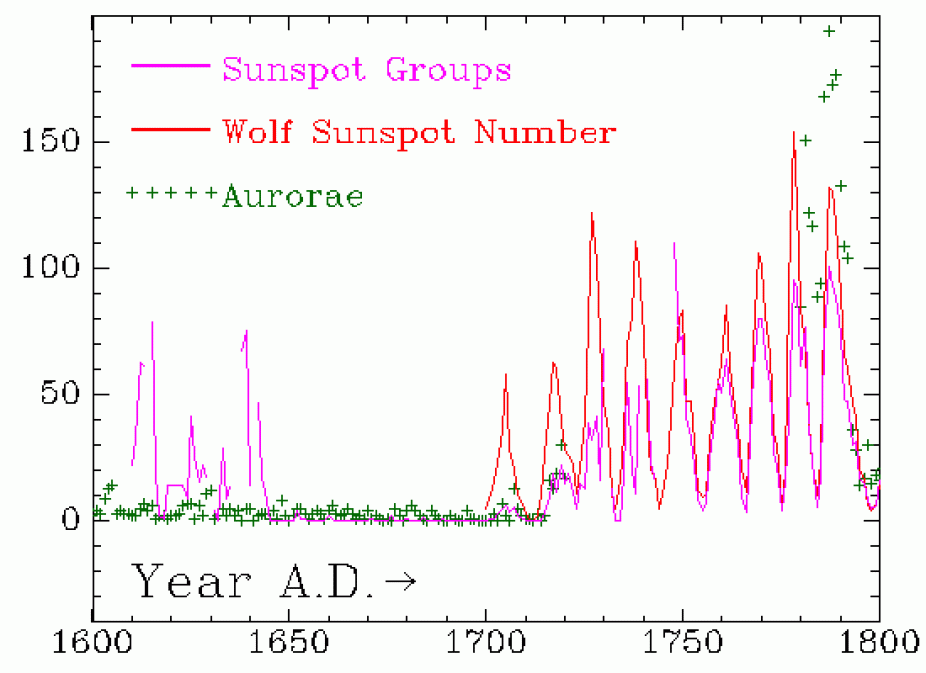
This very anachronistic plot shows the variation in observed sunspot numbers during the time period 1600-1800. The red curve is the Wolf sunspot number, and the purple line a count of sunspot groups based on a reconstruction by D.V. Hoyt. The green crosses are auroral counts, based on a reconstruction by K. Krivsky and J.P. Legrand.
Sunspots observations continued in the seventeenth century, with the most active observers being the German Johannes Hevelius (1611-1687) and the French Jesuit Jean Picard (1620-1682). Very few sunspots were observed from about 1645 to 1715, and when they were, their presence was noted as a noteworthy event by active astronomers. At that time a systematic solar observing program was underway under the direction of Jean Dominique Cassini (1625-1712) at the newly founded Observatoire de Paris, with first Picard, and later Philippe La Hire, carrying out the bulk of the observations. Historical reconstructions of sunspot numbers indicate that the dearth of sunspots was real, rather than the consequence of a lack of diligent observers. A simultaneous decrease in auroral counts further suggest that solar activity was greatly reduced during this time period.
This period is now known as the Maunder minimum, after the solar astronomer E.W. Maunder, who, following the pioneering historical investigations of Gustav Spörer (1822-1895), was most active and steadfast in investigating the dearth of sunspot sightings by astronomers active in the second half of the seventeenth century. The documented occurrence of exceptionally cold winters throughout Europe during those years may be causally related to reduced solar activity, although this remains a topic of controversy.
References and further readings
- Eddy, J.A. 1976, The Maunder Minimum, Science, 192, 1189-1203.
- Eddy, J.A. 1983, The Maunder minimum: a reappraisal, Solar Phys., 89, 195-207.
- Ribes, J. C., and Nesme-Ribes, E. 1993, The solar sunspot cycle in the Maunder minimum AD1645 to AD1715, Astronomy and Astrophysics, 276, 549-563.
- Hoyt, D.V. & Schatten, K.H. 1997, The Role of the Sun in Climate Change, Oxford University Press.
1687: The mass of the Sun
The mass of the Sun and its distance from the Earth are two very fundamental quantities that were only determined with reasonable accuracy in the eighteenth century. The first quantitative estimate of the Sun's mass is due to Isaac Newton (1642-1727). Newton presented the calculation in his "Principia Mathematica," making use of his newly formulated law of universal gravitation. Newton argued that stable planetary orbits resulted from a balance between centripetal and gravitational acceleration; In doing so he could finally provide a physical explanation for the three laws of planetary motions established empirically by Kepler. The ratio of Sun-to-Earth mass can be in principle determined without knowing the actual value of the universal gravitational constant. This only required a knowledge of orbital periods and radii. Newton, however, used too high a value for the solar parallax, thus grossly underestimating the Sun-Earth distance, and, consequently, underestimating the Sun-to-Earth mass ratio by more than a factor of ten (MSun/MEarth = 28700 instead of 332945). In later editions of his Principia (in 1713 and 1726), Newton used improved estimates of the solar parallax, and brought his estimate to within a factor of two of the modern value.
References and further readings
- Wilson, C. 1989, The Newtonian achievement in Astronomy, in The General History of Astronomy, vol. 2A, eds. R. Taton and C. Wilson, Cambridge University Press, pps. 234-274.
- Hufbauer, K. 1991, Exploring the Sun, The Johns Hopkins University Press.
1774-1801: The Physical nature of sunspots
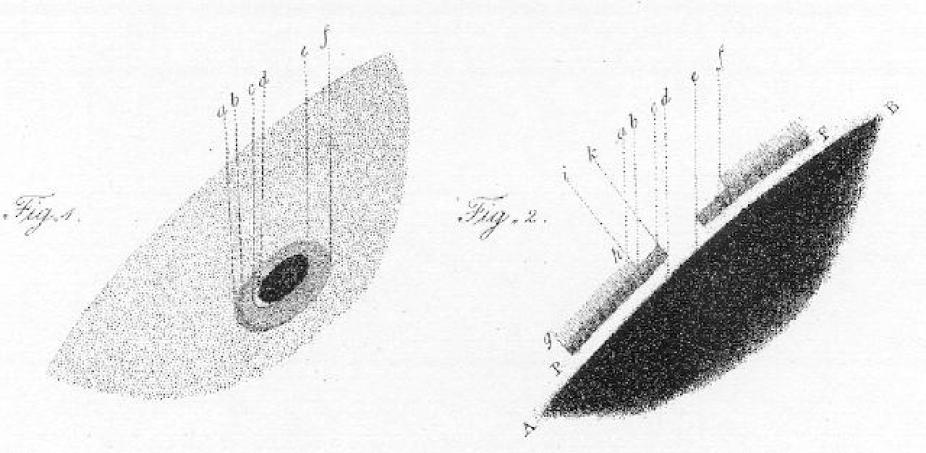
Reproduction of one of Herschel's original diagrams on the nature of sunspots. This hypothesis relies heavily on the asymmetric appearance of sunspots when seen near the solar limbs, as originally pointed out by A. Wilson in 1774.
Phil. Trans. 1801, vol. 91, pp. 265-318 (plate 18)
The physical nature of sunspots remained a topic of controversy for nearly three centuries. The universally opinionated Galileo proposed, with unusual reservation, that sunspots may be cloud-like structures in the solar atmosphere. Scheiner believed them to be dense objects embedded in the Sun's luminous atmosphere. In the late eighteenth century William Herschel (1738-1822; discoverer of the planet Uranus), following an hypothesis earlier put forth by A. Wilson in 1774, suggested that sunspots were openings in the Sun's luminous atmosphere, allowing a view of the underlying, cooler surface of the Sun (likely inhabited, in Herschel's then influential opinion).
References and further readings
- Berry, A. 1898, A Short History of Astronomy (Dover Reprint), chap. 12.
- Hufbauer, K. 1991, Exploring the Sun, The Johns Hopkins University Press.
1796: The nebular hypothesis and the Sun's origin
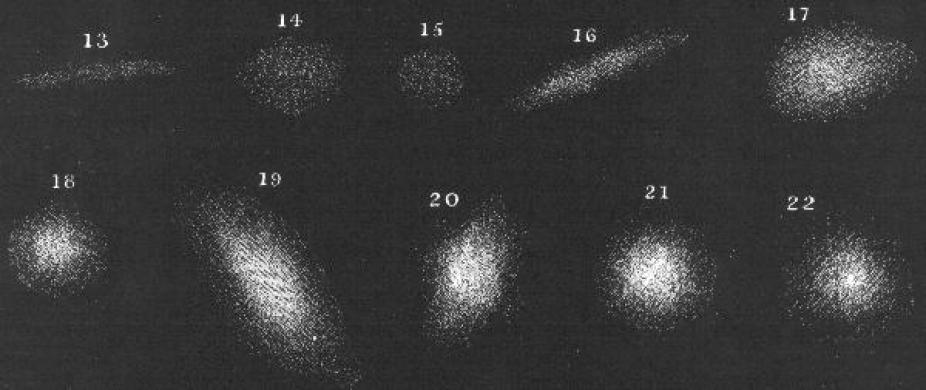
Drawing of Nebulae by William Herschel.
Reproduced from W. Herschel, Philosophical Transactions of the Royal Society of London 101 (1811), 269-336 (p. 336, Plate IV)
By the closing decade of the eighteenth century, the increasingly powerful reflecting telescopes built by the German-born English astronomer William Herschel had revealed the existence of a number of diffuse cloud-like structures, dubbed Nebulae. Herschel believed that these assorted Nebulae could be interpreted as different snapshots of an evolutionary sequence of gravitational collapse into one or more stars, along the lines proposed by Laplace.
Inspired by these observations, the French astronomer and mathematician Pierre Simon de Laplace (1749–1827) put forth his nebular hypothesis, in which the Sun and solar system formed from the gravitational collapse of an initially slowly rotating, large, diffuse gas cloud. Laplace's cosmological ideas were described in a popular work entitled Exposition du systè me du monde published in 1796. This marked a turning point in the history of science, since therein he categorically rejects the Biblical account of the creation of the Universe, and offers instead a physically-based theory that, in its main thrust if not in all details, remains valid to this day.
References and further readings
- Herschel, W. 1811, Astronomical Observations Relating to the Construction of the Heavens, Philosophical Transactions of the Royal Society of London 90, 284–292.
- Hoskin, M. (ed.) 1997, The Cambridge Illustrated History of Astronomy, Cambridge University Press, chap. 6.